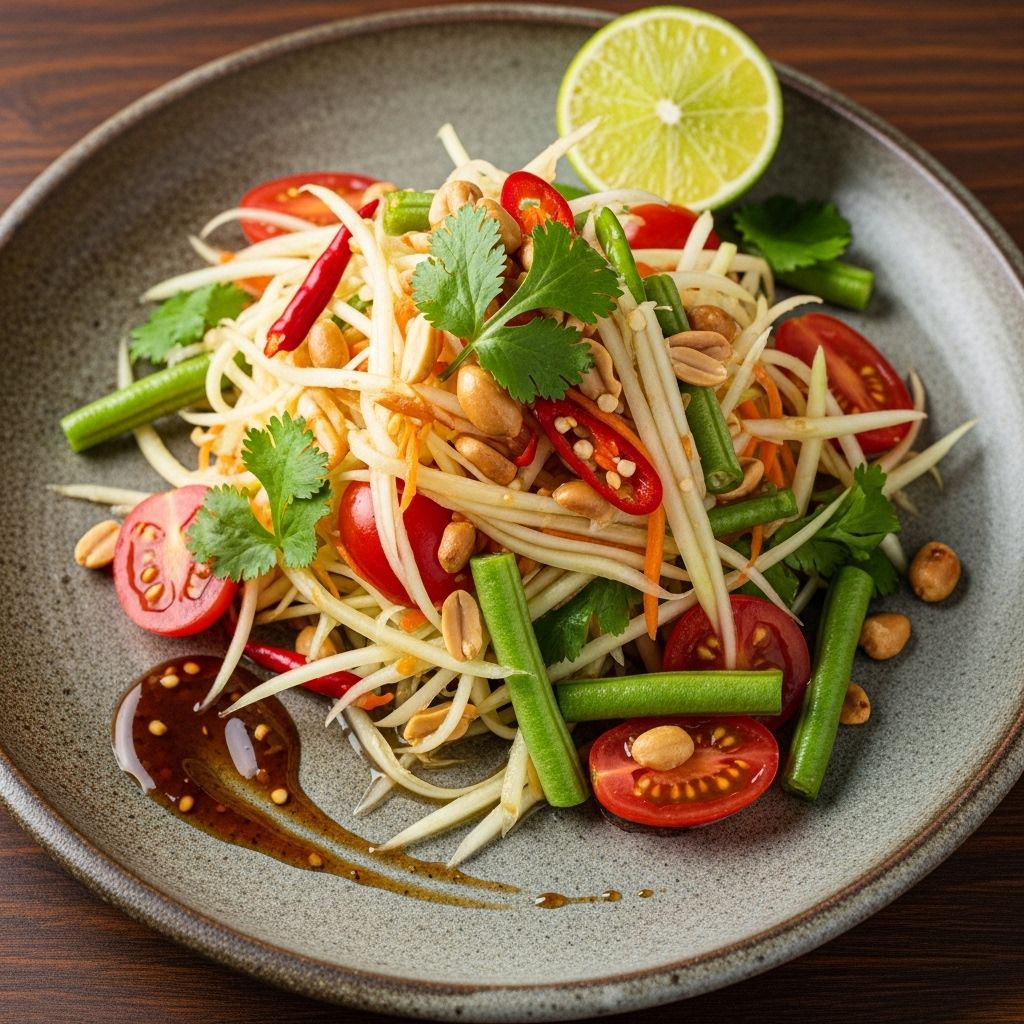Som Tam: The Vibrant World of Thai Green Papaya Salad
Discover the lively crunch and heat-sweet harmony that make this dish unforgettable.

Som Tam, also known as Thai Green Papaya Salad, is an iconic dish of Thai cuisine. With its lively blend of spicy, sour, sweet, and savory flavors, crunchy textures, and dazzling colors, Som Tam reigns as one of the most beloved salads in Southeast Asia. This article dives deeply into the origins, essential ingredients, step-by-step preparation, recipe variations, cultural context, and expert techniques for crafting a truly authentic green papaya salad at home.
What is Som Tam?
Som Tam (ส้มตำ), literally translated as “pounded sour,” is a popular dish throughout Thailand and much of Southeast Asia. It typically features shredded unripe green papaya tossed with garlic, chilies, fish sauce, lime juice, palm sugar, tomatoes, long beans, and roasted peanuts. What distinguishes Som Tam is its balance of sharp flavors and contrasting textures, making it incredibly refreshing and complex despite being quick to assemble.
- Signature Flavor Profile: A mix of spicy, sour, salty, and sweet.
- Key Texture: Crisp, crunchy shreds of green papaya and other vegetables.
- Popularity: Eaten as a snack, appetizer, or light main, especially in Thailand, Laos, and neighboring regions.
- Served With: Sticky rice, grilled meats, or as part of a broader meal spread.
The Origins and Cultural Importance of Som Tam
Som Tam originated in the Northeastern region of Thailand, known as Isaan, and shares roots with Lao green papaya salad, where it is called Tam Mak Hoong. The dish reflects the highly interactive, communal eating culture of Thailand, where meals are shared and flavors brightened at the table. Today, Som Tam is a staple in Thai street food markets, high-end restaurants, and family kitchens alike.
- Prepared fresh in a mortar and pestle (krok), highlighting the importance of technique.
- Commonly sold at street food stalls, where its preparation is a lively, sensory spectacle.
- Served for any meal of the day, often accompanied by sides like grilled chicken (“gai yang”) or sticky rice (“khao niao”).
- Variations abound by region and personal taste, reflecting Thailand’s diverse culinary landscape.
Essential Ingredients for Authentic Som Tam
Creating a classic Som Tam relies on sourcing the right ingredients. Each one plays a vital role in balancing the salad’s flavors and textures.
| Ingredient | Description and Role |
|---|---|
| Green Papaya | Unripe, firm papaya is shredded into fine strips. Its neutral flavor and crisp texture form the salad’s base. |
| Fresh Chilies | Bird’s eye chilies provide heat and fragrance. Spice levels can be adjusted. |
| Garlic | Pounded to release sharp, pungent aromas. |
| Fish Sauce | Offers essential salty, savory depth; a defining ingredient. |
| Palm Sugar | Lends natural, nuanced sweetness to balance the heat and tartness. |
| Lime Juice | The crucial acid, adding freshness and brightness. |
| Tomatoes | Cherry or grape tomatoes are crushed, adding juiciness and mild acidity. |
| Long Beans | Sliced and bruised; add crunch and subtle flavor. |
| Roasted Peanuts | Sprinkled on top for rich, toasty notes and textural contrast. |
| Dried Shrimp | An optional addition for umami and a hint of sea flavor. |
Other regional or personal additions: salted crab, fermented fish sauce (pla ra), or fresh green mango as a substitute for papaya.
Preparing Green Papaya: Tips and Techniques
Green papaya is not a type of fruit but an unripe version of orange papaya. The critical step is shredding it into long, thin, uniform strips that soak up the seasonings and retain crispness.
- Traditional Shredding: Use a sharp knife to score the papaya and then shave off strips. This can be time-intensive but creates the best texture.
- Mandoline/Julienne Peeler: Offers an efficient, consistent alternative. Just be cautious to avoid injury.
- Soaking in Ice Water: After shredding, a soak in ice water further firms the papaya for extra crunch.
Discard seeds and any soft, pulpy parts. Always use very firm, green papayas for optimal results.
Step-by-Step: How to Make Som Tam (Green Papaya Salad)
- Prepare All Ingredients
Julienne or shred the green papaya. Trim and cut long beans into 1- to 2-inch pieces. Rinse dried shrimp, halve tomatoes, chop garlic and chilies. - Set Up a Large Mortar and Pestle
A clay or heavy mortar (krok) is traditional, but a sturdy mixing bowl with a pestle or rolling pin can suffice. - Pound Garlic and Chilies
Mash several peeled garlic cloves and as many fresh chilies as desired. Bruising them draws out the flavors without rendering them into a puree. - Add Dried Shrimp and Long Beans
Gently pound these next, just until the beans split and shrimp break up slightly. - Season the Dressing
Stir in fish sauce, lime juice, and palm sugar. Taste and tweak to reach the balanced sweet-sour-salty-spicy profile. - Crush Tomatoes
Add cherry or grape tomatoes and lightly bruise to release some juices. - Toss in Green Papaya
Add the shredded papaya. Use a spoon to mix, lifting and pounding lightly to combine—the goal is to coat every strand, not to mush the papaya. - Finish and Serve
Transfer to a serving plate. Sprinkle generously with roasted peanuts. Serve immediately, garnished with extra lime or herbs if desired.
Expert Som Tam Tips
- Balance is Key: Adjust lime, sugar, and fish sauce to taste, as papaya and other vegetables can vary in sweetness and acidity.
- Work in Small Batches: If doubling or tripling the recipe, make the salad in smaller portions to ensure proper pounding and even flavor distribution.
- Use a Clay or Stone Mortar: Essential for the best flavor and texture, but if unavailable, a sturdy mixing bowl and wooden pestle or cocktail muddler work in a pinch.
- Crushing, Not Pureeing: Strive for bruised but intact ingredients; over-pounding will turn the salad mushy.
- Serve Immediately: The salad is most vibrant and crisp when eaten right after making.
Som Tam Variations Across Thailand
While the core recipe remains consistent, Som Tam offers remarkable regional and personal variability, each version putting its spin on the flavor spectrum.
- Som Tam Thai: The most widely known version, often a bit sweeter and milder, with peanuts and sometimes dried shrimp.
- Som Tam Lao / Som Tum Pla Ra: More robust, funkier, and sometimes includes fermented fish sauce (“pla ra”) or salted crab (“pu”), with little to no sugar and no peanuts.
- Som Tam Poo: Salty black crab added for extra brine and texture.
- Som Tam Ponlamai: Fruit salad variation using apple, guava, or mango in addition to or instead of papaya.
- Vegetarian/Vegan Som Tam: Omit fish sauce and dried shrimp, substituting soy sauce or a vegan fish sauce and salted peanuts for crunch.
| Version | Main Differences |
|---|---|
| Som Tam Thai | Mild, sweet, includes peanuts and dried shrimp |
| Som Tam Lao | No peanuts, funkier with pla ra, less sweet, more chilies |
| Som Tam Poo | Adds salted black crab |
| Som Tam Ponlamai | Uses various fruits instead of or with papaya |
Serving and Pairing Suggestions
- Sticky Rice (Khao Niao): Traditionally served as an accompaniment, ideal for offsetting the salad’s bold flavors.
- Grilled Chicken (Gai Yang): A classic street stall pairing, providing protein and savory depth.
- Lettuce or Cabbage Leaves: Used to scoop up bites of salad and temper the spiciness.
- Other Grilled Meats, Sausages, and Fried Fish: Common additions to turn Som Tam into a broader meal.
Som Tam’s versatility also makes it a palate-awakening addition to any picnic or barbecue.
Frequently Asked Questions (FAQs)
Q: Can I substitute another vegetable for green papaya?
A: Yes. Green mango, kohlrabi, or even shredded carrot or cucumber offer similar crispness and work well in a pinch.
Q: Is Som Tam always extremely spicy?
A: Not necessarily. Spice level is adjustable; ask for fewer chilies or omit them entirely for a milder version.
Q: How long can I store Som Tam?
A: For best texture and flavor, enjoy immediately. If needed, refrigerate up to 2 hours, but expect some softening. Do not freeze.
Q: Is Som Tam gluten-free and healthy?
A: Yes—so long as all condiments used are gluten-free. It’s also naturally low in calories and rich in vitamins and fiber.
Q: What if I don’t have a mortar and pestle?
A: Use a large bowl and heavy pestle or muddler. Though less traditional, you can still bruise and combine ingredients effectively this way.
Expert Tips for Som Tam Success
- Shred papaya just before serving to retain maximum crunch.
- Use freshly toasted peanuts for a superior taste and aroma.
- Adjust the seasoning ingredients incrementally, tasting as you go.
- Pound gently for the perfect lightly bruised texture.
- Experiment with regional add-ins like pickled garlic, salted egg, or a dash of tamarind for new flavor notes.
Why Som Tam Remains a Thai Favorite
With its irresistible fusion of spicy, sour, salty, and sweet; vibrant colors and bold textures; and endless customization, Som Tam stands as a testament to Thailand’s culinary ingenuity. Learning to make Som Tam at home offers not just a delicious salad, but a gateway into the bustling, spirited world of Thai food culture. Whether you’re a newcomer or a longtime Thai cuisine lover, green papaya salad invites endless experimentation and enjoyment—best made, shared, and savored right away.
References
Read full bio of Shinta












